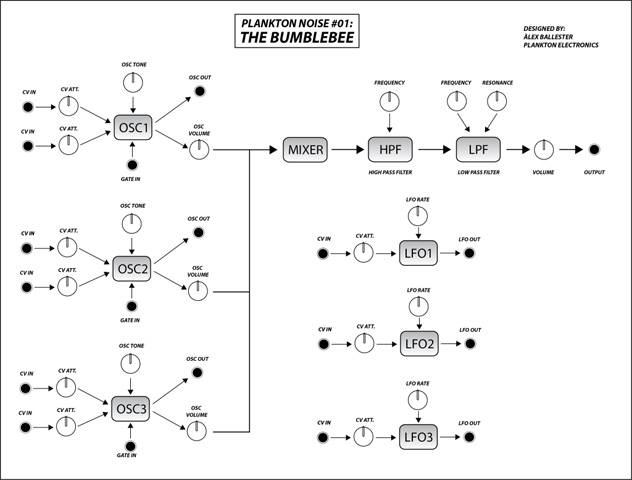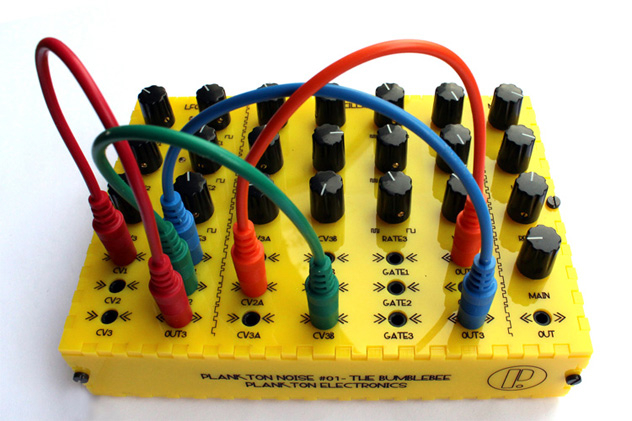- The latest DIY instrument from Barcelona's Plankton Electronics is a noise machine and drone synth called The Bumblebee. It's fairly simple in design, but offers loads of possibilities for making strange tones. It's available as a DIY kit, which includes the PCB and components, or a fully assembled desktop version. (The desktop case is also available and sold separately.) The PCB is modular-friendly, if you can handle making your own front panel, and the large quantity of CV connectivity and knobs makes this worth the effort for any modular enthusiast.
The signal flow is basically three square-wave oscillators routed through two filters and an amplifier, with lots of modulation and CV along the way. Each of the oscillators has its own level knob, which acts as a mixer and a rate control that determines its frequency, and each has an individual output so they can be mixed separately or even used as FM-style modulators. There are two CV inputs per oscillator to modulate pitch, with an attenuation knob for controlling modulation depth. The three LFOs on the left of the front panel are also square-wave oscillators that are basically the same design but at slower rates. Each LFO has a CV input and attenuation knob to modulate its rate. The three oscillators are fed to a high-pass filter followed by a low-pass filter with resonance. I found the low-pass to be pretty noisy and aggressive, and it helped add color to the tone. A single mono output is the main audio-out.
 Earning its name, the Bumblebee can sound like a swarm of bees: a modulating and complex buzz. Using gate inputs for each of the oscillators, it's possible to sequence them, and it sounded like a decent subtractive synth. I successfully used an Arturia Microbrute's gate-out as a sequencer with a single patch. Then patching the individual outs as the gate-in of the next two oscillators allowed all three oscillators to be triggered at once. Tuning the oscillators to different intervals can produce three-voice chords. I also used the LFOs from the Bumblebee as a modulator for other synths. Patching the Bumblebee into itself, though, can provide a lot of entertainment, so you don't necessarily need other gear to take advantage of its patching capabilities—it's fully analog and raw, and it has wide range of noisy mayhem on its own. Simply turning all of the oscillators to high levels can create a very welcome distortion.
Earning its name, the Bumblebee can sound like a swarm of bees: a modulating and complex buzz. Using gate inputs for each of the oscillators, it's possible to sequence them, and it sounded like a decent subtractive synth. I successfully used an Arturia Microbrute's gate-out as a sequencer with a single patch. Then patching the individual outs as the gate-in of the next two oscillators allowed all three oscillators to be triggered at once. Tuning the oscillators to different intervals can produce three-voice chords. I also used the LFOs from the Bumblebee as a modulator for other synths. Patching the Bumblebee into itself, though, can provide a lot of entertainment, so you don't necessarily need other gear to take advantage of its patching capabilities—it's fully analog and raw, and it has wide range of noisy mayhem on its own. Simply turning all of the oscillators to high levels can create a very welcome distortion.
 The kit took about eight hours total for full assembly, and I'd rate the project as slightly more complicated than "beginner." There are, thankfully, no wires in the design; all jacks and potentiometers are mounted to the circuit board and fit nicely into the enclosure, which is available in translucent orange, opaque yellow or a combination of both. The LEDs, which indicate oscillator and LFO rates, are all blue, so it is a very attractive piece as well. It doesn't ship with a power supply, but the 9-volt plug it needs is very common—it's the same kind used for most guitar pedals. (Optionally, there is a place on the circuit board for a 9-volt battery.)
It's unfortunate that both the LFOs and oscillators are only square wave. If they were wave shape-variable, this would be a much more versatile unit. However, it isn't designed to be a subtractive synth for bass lines or leads, even though those are possible. The Bumblebee is more of an experimental playground, and it makes an excellent project for anyone who has even a bit of soldering experience. As always with soldering projects, work carefully in a well-lit, ventilated space, and remember to take your time—I still have some connections of my own to check. The high pass filter and main output knobs don't have the range they should, which could be a resistor in the wrong place. But that's the beauty of the DIY projects: they can train you to make repairs on your other gear as well.
Ratings:
Cost: 3.5/5
Versatility: 2.5/5
Sound: 3.5/5
Ease of build: 3.5/5
The kit took about eight hours total for full assembly, and I'd rate the project as slightly more complicated than "beginner." There are, thankfully, no wires in the design; all jacks and potentiometers are mounted to the circuit board and fit nicely into the enclosure, which is available in translucent orange, opaque yellow or a combination of both. The LEDs, which indicate oscillator and LFO rates, are all blue, so it is a very attractive piece as well. It doesn't ship with a power supply, but the 9-volt plug it needs is very common—it's the same kind used for most guitar pedals. (Optionally, there is a place on the circuit board for a 9-volt battery.)
It's unfortunate that both the LFOs and oscillators are only square wave. If they were wave shape-variable, this would be a much more versatile unit. However, it isn't designed to be a subtractive synth for bass lines or leads, even though those are possible. The Bumblebee is more of an experimental playground, and it makes an excellent project for anyone who has even a bit of soldering experience. As always with soldering projects, work carefully in a well-lit, ventilated space, and remember to take your time—I still have some connections of my own to check. The high pass filter and main output knobs don't have the range they should, which could be a resistor in the wrong place. But that's the beauty of the DIY projects: they can train you to make repairs on your other gear as well.
Ratings:
Cost: 3.5/5
Versatility: 2.5/5
Sound: 3.5/5
Ease of build: 3.5/5
 Earning its name, the Bumblebee can sound like a swarm of bees: a modulating and complex buzz. Using gate inputs for each of the oscillators, it's possible to sequence them, and it sounded like a decent subtractive synth. I successfully used an Arturia Microbrute's gate-out as a sequencer with a single patch. Then patching the individual outs as the gate-in of the next two oscillators allowed all three oscillators to be triggered at once. Tuning the oscillators to different intervals can produce three-voice chords. I also used the LFOs from the Bumblebee as a modulator for other synths. Patching the Bumblebee into itself, though, can provide a lot of entertainment, so you don't necessarily need other gear to take advantage of its patching capabilities—it's fully analog and raw, and it has wide range of noisy mayhem on its own. Simply turning all of the oscillators to high levels can create a very welcome distortion.
Earning its name, the Bumblebee can sound like a swarm of bees: a modulating and complex buzz. Using gate inputs for each of the oscillators, it's possible to sequence them, and it sounded like a decent subtractive synth. I successfully used an Arturia Microbrute's gate-out as a sequencer with a single patch. Then patching the individual outs as the gate-in of the next two oscillators allowed all three oscillators to be triggered at once. Tuning the oscillators to different intervals can produce three-voice chords. I also used the LFOs from the Bumblebee as a modulator for other synths. Patching the Bumblebee into itself, though, can provide a lot of entertainment, so you don't necessarily need other gear to take advantage of its patching capabilities—it's fully analog and raw, and it has wide range of noisy mayhem on its own. Simply turning all of the oscillators to high levels can create a very welcome distortion.
 The kit took about eight hours total for full assembly, and I'd rate the project as slightly more complicated than "beginner." There are, thankfully, no wires in the design; all jacks and potentiometers are mounted to the circuit board and fit nicely into the enclosure, which is available in translucent orange, opaque yellow or a combination of both. The LEDs, which indicate oscillator and LFO rates, are all blue, so it is a very attractive piece as well. It doesn't ship with a power supply, but the 9-volt plug it needs is very common—it's the same kind used for most guitar pedals. (Optionally, there is a place on the circuit board for a 9-volt battery.)
It's unfortunate that both the LFOs and oscillators are only square wave. If they were wave shape-variable, this would be a much more versatile unit. However, it isn't designed to be a subtractive synth for bass lines or leads, even though those are possible. The Bumblebee is more of an experimental playground, and it makes an excellent project for anyone who has even a bit of soldering experience. As always with soldering projects, work carefully in a well-lit, ventilated space, and remember to take your time—I still have some connections of my own to check. The high pass filter and main output knobs don't have the range they should, which could be a resistor in the wrong place. But that's the beauty of the DIY projects: they can train you to make repairs on your other gear as well.
Ratings:
Cost: 3.5/5
Versatility: 2.5/5
Sound: 3.5/5
Ease of build: 3.5/5
The kit took about eight hours total for full assembly, and I'd rate the project as slightly more complicated than "beginner." There are, thankfully, no wires in the design; all jacks and potentiometers are mounted to the circuit board and fit nicely into the enclosure, which is available in translucent orange, opaque yellow or a combination of both. The LEDs, which indicate oscillator and LFO rates, are all blue, so it is a very attractive piece as well. It doesn't ship with a power supply, but the 9-volt plug it needs is very common—it's the same kind used for most guitar pedals. (Optionally, there is a place on the circuit board for a 9-volt battery.)
It's unfortunate that both the LFOs and oscillators are only square wave. If they were wave shape-variable, this would be a much more versatile unit. However, it isn't designed to be a subtractive synth for bass lines or leads, even though those are possible. The Bumblebee is more of an experimental playground, and it makes an excellent project for anyone who has even a bit of soldering experience. As always with soldering projects, work carefully in a well-lit, ventilated space, and remember to take your time—I still have some connections of my own to check. The high pass filter and main output knobs don't have the range they should, which could be a resistor in the wrong place. But that's the beauty of the DIY projects: they can train you to make repairs on your other gear as well.
Ratings:
Cost: 3.5/5
Versatility: 2.5/5
Sound: 3.5/5
Ease of build: 3.5/5